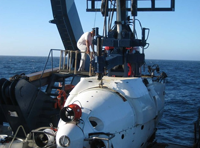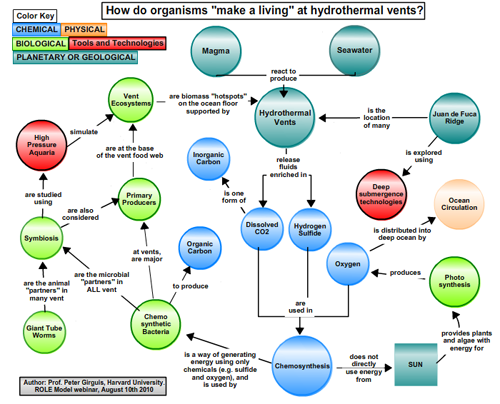|
|
Exploring hydrothermal vents and their amazing productivity
08/11/2010
| Carla Lauter, ODYSEA LLC
(Ocean Systems)
Tags: ROLE Model webinar, hydrothermal vents, 08.10.10 webinar
|
 Peter enters the Deep Submergence Vehicle ALVIN to visit a vent on the Juan de Fuca Ridge. |
Harvard scientist Peter Girguis shared some of the secrets of the deep and strange hydrothermal vent ecosystems found in the Juan de Fuca ridge area through a new concept map presentation at last night's second "ROLE Model" webinar.
Peter, our featured scientist presenter, had just returned from a trip to the area where he and other colleagues continued to study vent ecosystems. Using specialized equipment (including trips in the famous submersible ALVIN), the scientists were able to get more insight into an ecosystem which are based entirely on chemicals being expelled from vents in the sea floor. No light reaches these depths, and the process "chemosynthesis" (carried out by bacteria) forms the base of the food chains. Peter presented a concept map that discussed his study area involving primary productivity and symbiotic relationships between tube worms and chemosynthetic bacteria.
 Peter Girguis' concept map presented at the 08.10.10 ROLE Model Webinar. |
Peter's talk also highlighted the importance of research on these organisms because of their potential to tell us about life on other planets. Some of the moons in our own solar system may have similar combinations of geothermal activity and chemical makeup of the oceans. If life can develop on the sea floor in the absence of any light to photosynthesize with, it seems as if the same could possibly happen on a planet that's too far away from the sun to have enough light to support life through photosynthesis.
Creating a Collaborative Consensus
As many of us have experienced, working on a group project can sometimes present its own unique challenges. How do you get everyone involved (especially if they are from different disciplines, departments or projects) to agree on a single plan or course of action? The featured educator presenter for this session, Louise McMinn shared her insight from her experiences working on a complex project within her school district. Her solution? Transform meeting notes and discussion into a concept map.
Louise shared her experiences implementing an interdisciplinary grant on water quality with her colleagues. By using concept maps to define the roles of the teachers and students involved in the project, she found it easier to get everyone "on the same page" about the project's execution. Students embraced their assigned "jobs" with enthusiasm, and fellow educators felt connected to the project, even across disciplines.
Want to keep a copy of the map presented in this webinar?
Download a this map here. (PDF, 123 KB)
To view the interactive version of this map, click here. When asked for a visitor's password, choose ROLEModel2 as the username and cosee as the password.
To share the map to your own profile, login to the Concept Map Builder with the username of ROLEModel2 and the password 2010. Open the map and click "share" to send a copy of the map to yourself (if you have already registered for a COSEE profile.)
Need to register? Register now!
Have thoughts on this post? Send us a note and we'll share your ideas!
|

